Adopting the ‘American way’: Ireland and the Marshall Plan, 1947–57
Published in 20th-century / Contemporary History, Features, Issue 3 (May/Jun 2008), Volume 16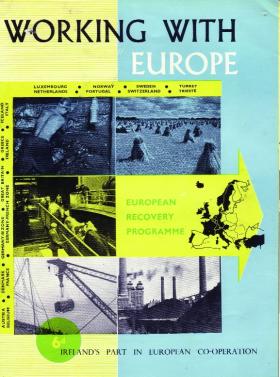
Working with Europe, a pamphlet produced by the European Recovery Programme (ERP) outlining ‘Ireland’s part in European Co-operation’, and Europe: all our colours to the mast by Dutch graphic artist Reyn Dirksen, winner of an ERP poster competition in 1950. (National Archives of Ireland and George C. Marshall Foundation)
In June 1947 the Irish economy continued to display the effects of wartime dislocation: rationing, rising inflation, falling living standards and frequent strikes. Ireland also shared many of the prevailing European economic trends: increasing reliance on the dollar area for imports and a worsening balance of payments position. While the war had left Ireland with ample sterling assets with which to pay for imports, Department of Finance officials feared that reserves were being ‘frittered away on consumer goods’. In addition, the exchange crisis in June 1947 meant that sterling reserves could no longer be automatically converted to dollars, and vital imports from the dollar area could therefore not be purchased. London’s dollars had to be exchanged for Washington’s dollars. Against this economic and financial background, and with Irish political and diplomatic energies directed at rehabilitating an international reputation damaged by neutrality, Ireland had little choice but to participate in the ERP.
Motivated by fear of communism
The economic reasons for including Ireland were in fact influenced less by concern for the plight of the Irish economy than by considerations of the role Ireland could play in relation to Britain and Europe. Washington officials believed that Ireland’s role in the ERP related to producing food for export to Europe, and particularly Britain. But without some external assistance Ireland would be unable to meet either its own needs or Britain’s. Relieving Ireland’s dollar problems would also reduce the excessive drain on Britain’s hard currency reserves. More generally, US policy-makers feared the emergence of fertile conditions for the spread of communism in Britain as well as elsewhere.
The US decision to include Ireland was not an automatic one. Anger with wartime neutrality was still strong in Washington but was counter-balanced by a perceived need, for reasons of security, tradition and the latent strength of the Irish-American lobby, to incorporate Ireland into some US-sponsored organisation. Though anti-communism had long been a feature of Irish life, George Garrett, US minister to Dublin, believed that Ireland was as vulnerable as any other European country to communist infiltration as a result of deteriorating economic and social conditions. But US annoyance was soon evident: the bulk of the assistance came in the form of loans rather than grants.
Emphasis on agriculture
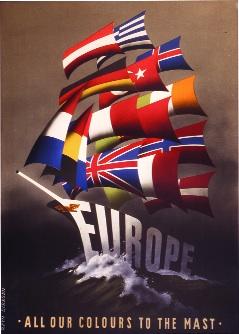 From the beginning, Washington’s plans for Ireland emphasised agricultural development, and this was reflected in the backgrounds of the men appointed as chief of the Economic Co-operation Admin-istration (ECA, the ERP administration) mission to Ireland. Joseph Carrigan (1948–50), Paul Miller (1950–1) and Albert Dexter (1951–2) had all taught agricultural science either at university or high school level and had been involved with agricultural extension programmes. Their focus on agriculture coincided with those of Irish policy-makers at least until the 1949 devaluation crisis, when ECA attention shifted to industry as a way of boosting dollar earnings.
From the beginning, Washington’s plans for Ireland emphasised agricultural development, and this was reflected in the backgrounds of the men appointed as chief of the Economic Co-operation Admin-istration (ECA, the ERP administration) mission to Ireland. Joseph Carrigan (1948–50), Paul Miller (1950–1) and Albert Dexter (1951–2) had all taught agricultural science either at university or high school level and had been involved with agricultural extension programmes. Their focus on agriculture coincided with those of Irish policy-makers at least until the 1949 devaluation crisis, when ECA attention shifted to industry as a way of boosting dollar earnings.
Dollars were not offered without strings attached. Not only did each government have to deal with an ECA mission but data on production, trade, consumption, balance of payments, investment and financial policy had to be provided on a quarterly and annual basis to officials in ECA Paris, the State Department in Washington and the Organisation for European Economic Co-operation (OEEC, the participant countries’ organisation) in Paris. In addition, an annual report and a four-year long-term recovery programme were required. Consequently, an ERP administrative structure was created within the Irish bureaucracy.
Ireland’s long-term recovery programme, submitted to the OEEC in July 1948, outlined how a reasonable level of economic activity would be attained when ERP aid ended. The extent to which this ‘planning’ exercise was taken seriously by the Irish has to be questioned. Exports would double by 1952–3, the volume of agricultural output would expand by 22% over the 1947 figure, and industrial production would rapidly surpass the pre-war level attained in 1946. Nonetheless, the general targets set for agriculture and those negotiated in June 1948 under the Anglo-Irish Trade agreement reaffirmed the government’s policy to achieve pre-war levels of agricultural exports in livestock, eggs, bacon, butter, sheep and poultry. With the expansion of the agricultural sector at the core of the programme, two-thirds of ERP-financed imports were agricultural and one-third consisted of machinery and raw materials for industry. ERP-funded imports totalled 17% of total imports in the period 1948–51.
Inter-party government
In terms of use of the loan and grant counterpart funds (the local currency equivalent of a country’s ERP allocation), two main purposes had ECA approval: capital investment projects or debt retirement. But ECA officials in Ireland had less authority in this regard because most of the counterpart funds were loans rather than grants. Thus they could advise but not direct the government in their use. Irrespective of this, there was no lack of ideas about their use. The change of government in Ireland in February 1948 (the first in sixteen years) brought to office five political parties, plus independents. All the government partners saw in increased state capital investment the remedy to unemployment, emigration and under-development. Investment was directed at the development of infrastructure and natural resources rather than the debt retirement favoured by Department of Finance officials. Between 1949 and 1952, 49.5% of the government’s capital expenditure programme was funded by the ERP. Substantial impetus was given towards supporting rural electrification, reforestation, land reclamation and the provision of houses and hospitals.
After ERP ended, grant counterpart funds assisted projects relating to ground limestone, bovine tuberculosis, pasteurisation of milk, the establishment of the Agricultural Institute (An Foras Talúntas) at Johnstown Castle, Co. Wexford, an educational exchange programme between the US and Ireland called the Fulbright programme, the provision of additional laboratories for the Institute for Industrial Research and Standards, and the costs of technical assistance programmes. Grants went to the Irish Countrywomen’s Association, Muintir na Tíre and Macra na Feirme. All the projects sought to improve the economy through promoting research, education, productivity or rural cooperation. Funding for them did not come through until the mid- to late 1950s, when, ironically, the political climate was more attuned to such messages than during the ERP years; part of the long-term impact of the ERP may therefore be dated from this time onwards.
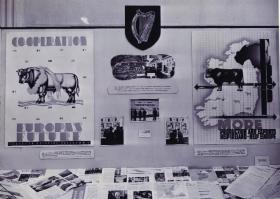
Part of an ERP exhibition in Ireland. Note the emphasis on agriculture. (National Archives of Ireland)
The American way
The ERP did not just operate at the level of officials and ministers; the push for production and productivity through the Technical Assistance Programme (TAP) brought workers, owners, managers and trade unionists into contact with ERP messages. ECA administrator Paul Hoffman wrote: ‘We must export our skills as well as our dollars . . . the import of “know-how” is the basis of the technical assistance programme at ECA’. This belief in the regenerative powers of American expertise ran contrary to Marshall’s message of self-help but it underpinned the TAP. If European labour and management were familiarised with American practices and methods, they too would reap the benefits of greater efficiency, higher productivity and cheaper production, and in turn recovery and prosperity were achievable. European workers and managers would visit the US, experience the American way of working and living and apply the lessons learnt when they returned home.
Though the ECA and State Department, like the Irish government, had targeted agriculture as the way forward in 1948, by late 1949 the ECA was also focusing on industrial development. Increasing dollar revenue from Irish exports had become imperative. Such exports totalled a mere $2 million in 1949, representing 2.1% of total exports. After six months of government inactivity and the possibility of losing the dedicated ECA budget for technical assistance, in early 1950 Carrigan sent a démarche to MacBride to urge him to move on the matter. The outbreak of the Korean War in June 1950 provided an added impetus to remodel the structure of European business and industry.
By the end of 1952 there had been 37 visits to the US by representatives from government departments, semi-state bodies, Muintir na Tíre, the Irish Countrywomen’s Association, Macra na Feirme, the Congress of Irish Unions, the Irish Transport and General Workers Union, university students, hoteliers (including the late Brendan O’Regan, then catering controller at Shannon airport), the Irish Paper Mills Association and the Flake Oatmeal Millers Association (21 related to agriculture and sixteen to industry). Additionally, five projects involved visits to Ireland by US experts, two in agriculture and three in industry.
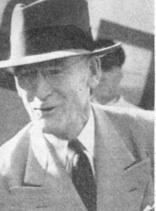
Joseph Carrigan, chief of the Economic Co-operation Administration (ECA, the ERP administration) mission to Ireland 1948–50. (National Archives of Ireland)
The significance of the TAP cannot be appraised in terms of dollars spent or structures put in place (the first productivity body in Ireland was established in 1959) but rather in terms of the transfer of skills and knowledge. In Ireland, however, the experience of the visits and the advice received from ERP experts—emphasising industrial and agricultural efficiency and productivity, market diversification, export promotion, tourist development, attracting foreign investment and trade liberalisation—rested uneasily with governments committed to an introspective, self-sufficient rural vision for Ireland.
Propaganda
It was not sufficient for the ECA to export the ‘American way’ as the remedy for Europe’s recovery and to defeat communism. The concepts of growth, modernisation and prosperity had to be publicised and formed the basis of an ERP-funded propaganda programme using press releases, publications, posters, photographs, exhibitions, radio programmes, newsreel stories and films, including The Promise of Barty O’Brien, with a script by Seán O’Faoláin and Abbey actors Harry Brogan and Eileen Crowe. But the Irish government-funded publicity material bore an additional message. Despite ECA and OEEC criticism, MacBride insisted that the injustice of the partition of the national territory be highlighted also.
When Marshall Aid to Ireland was suspended in May 1951, Irish economic policy remained concerned with maintaining its privileged position for agricultural exports within the British market and protecting indigenous industry. Furthermore, a change of government in 1951, combined with a recurrence of balance of payments problems, forced the government to adopt restrictive fiscal measures that led to economic depression. Yet it must also be noted that many of Ireland’s ERP lessons would influence Irish economic thinking in the late 1950s. Marshall Aid compelled Ireland to examine the structural weaknesses in the economy, and while its lessons could be ignored in the short term, they could not be in the long term.
In political terms, though the OEEC provided Ireland with a valuable opportunity to break out of its isolationist position, it remained on the
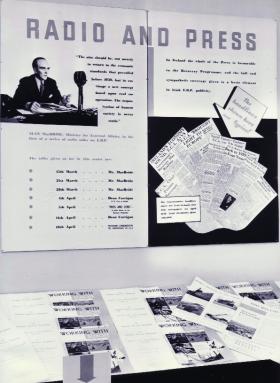
Despite ECA and OEEC criticism, Minister for External Affairs Seán MacBride insisted that the injustice of the partition of the national territory be highlighted also. (National Archives of Ireland)
periphery of the key American objective—European integration—until the early 1960s. It also refused to join the North Atlantic Treaty Organisation, and by raising partition at various European forums it
annoyed Washington policy-makers. Their hostility was more than obvious when Ireland refused to agree to the ERP successor legislation, the Mutual Security Act, because of the implications for Irish neutrality. In both economic and political terms, Irish participation in the ERP rested on principles and practices more suited to the conditions of the inter-war period, specifically from 1932 onwards. The Marshall planners revealed this major weakness, and while many of their recommendations were not adopted at the time, they would be in the following decades.
Bernadette Whelan lectures in history at the University of Limerick.
Further reading:
T. Geiger and M. Kennedy (eds), Ireland, Europe and the Marshall Plan (Dublin, 2004).
B. Whelan, Ireland and the Marshall Plan 1947–1957 (Dublin, 2000).
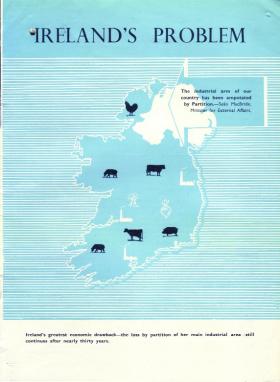
Ireland’s problem —‘The industrial arm of our country has been amputated by Partition’.
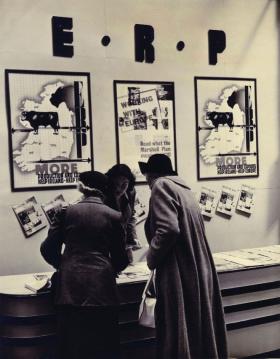
ERP exhibitions such as this were part of a propaganda programme that also used press releases, publications, posters, photographs, radio programmes, newsreel stories and films. (National Archives of Ireland)
















